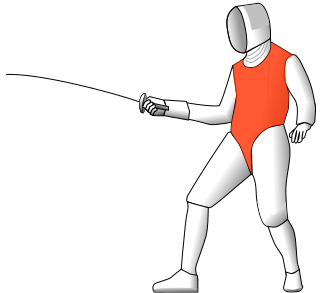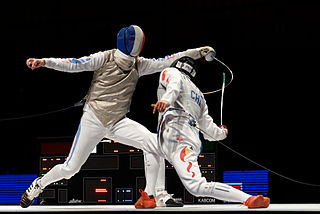
Fencing is a combat sport that features sword fighting. The three disciplines of modern fencing are the foil, the épée, and the sabre ; each discipline uses a different kind of blade, which shares the same name, and employs its own rules. Most competitive fencers specialise in one discipline. The modern sport gained prominence near the end of the 19th century and is based on the traditional skill set of swordsmanship. The Italian school altered the historical European martial art of classical fencing, and the French school later refined that system. Scoring points in a fencing competition is done by making contact with an opponent.

A parry is a fencing bladework maneuver intended to deflect or block an incoming attack.

A foil is one of the three weapons used in the sport of fencing. It is a flexible sword of total length 110 cm (43 in) or under, rectangular in cross section, weighing under 500 g (18 oz), with a blunt tip. As with the épée, points are only scored by making contact with the tip. The foil is the most commonly used weapon in fencing.

In modern fencing, a lamé is an electrically conductive jacket worn by foil and sabre fencers in order to define the scoring area and register contact with it. Lamés are wired by use of a body cord to a scoring machine, which allows the other person's weapon to register touches when their tips contact the lamé.

The épée, also rendered as epee in English, is the largest and heaviest of the three weapons used in the sport of fencing. The modern épée derives from the 19th-century épée de combat, a weapon which itself derives from the French small sword.
Classical fencing is the style of fencing as it existed during the 19th and early 20th centuries. According to the 19th-century fencing master Louis Rondelle,
A classical fencer is supposed to be one who observes a fine position, whose attacks are fully developed, whose hits are marvelously accurate, his parries firm, and his ripostes executed with precision. One must not forget that this regularity is not possible unless the adversary is a party to it. It is a conventional bout, which consists of parries, attacks, and returns, all rhyming together.

The sabre is one of the three disciplines of modern fencing. The sabre weapon is for thrusting and cutting with both the cutting edge and the back of the blade.

Fencing has been contested at every Summer Olympic Games since the birth of the modern Olympic movement at the 1896 Summer Olympics in Athens. There are three forms of Olympic fencing:

Nedo Nadi was one of the best Italian fencers of all time. He is the only fencer to win a gold medal in each of the three weapons at a single Olympic Games and won the most fencing gold medals ever at a single Games—five. Nadi won six Olympic gold medals in total.

The following outline is provided as an overview of and topical guide to fencing:

The flick is a technique used in modern fencing. It is used in foil and to a lesser extent, épée.
In fencing, the grip is the part of the weapon which is gripped by the fencer's hand.

The flèche is an aggressive attacking technique in fencing, used with foil and épée.
The Amateur Fencers League of America (AFLA) was founded on April 22, 1891, in New York City by a group of fencers seeking independence from the Amateur Athletic Union. As early as 1940, the AFLA was recognized by the Fédération Internationale d'Escrime (FIE) and the United States Olympic Committee as the national governing body for fencing in the United States.
Priority or right of way is the decision criterion used in foil and sabre fencing to determine which fencer receives the touch, or point, when both fencers land a hit within the same short time-frame. After this window, if one fencer had already landed a hit, the electrical scoring apparatus would "lock-out," or fail to record, an opponent's subsequent hit, and thus the one fencer to land a hit is awarded the touch. In épée fencing, if both fencers land valid hits at the same time, they each receive a point. Because of this, foil and sabre are considered conventional weapons. After a halt, a referee parses what happened into actions, from which it can be determined whether to award a point or not.
Fencing practice and techniques of modern competitive fencing are governed by the Fédération Internationale d'Escrime (FIE), though they developed from conventions developed in 18th- and 19th-century Europe to govern fencing as a martial art and a gentlemanly pursuit. The modern weapons for sport fencing are the foil, épée, and sabre.

Tactics are very important to playing well in modern fencing and although technique is important in the sport, using an array of tactics will help fencers make the most of that technique.
This is a glossary of terms used in fencing.
The Ukrainian Fencing Federation commonly known by the acronym NFFU, established in 1992, is the governing body of Ukrainian fencing. Through 2022, Ukrainian fencers won 230 medals combined in the Olympic Games, World championships, and European championships.

The fencing competitions at the 2024 Summer Olympics in Paris were run from 27 July to 4 August at the Grand Palais strip. A total of 212 fencers, with an equal distribution between men and women, competed across twelve medal events at the Games. For the second straight time, Paris 2024 witnessed both men and women fence against each other in the individual and team events held in all three weapons.













